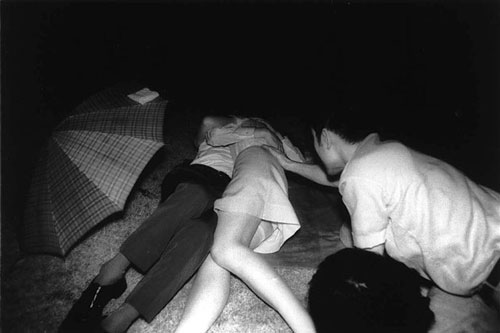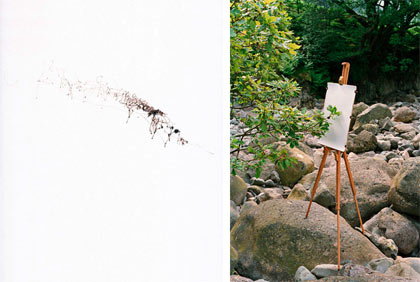kottke.org posts about photography
Dr. Jay Parkinson M.D. emailed in to tell me about his new medical practice in Williamsburg. He’s got no office (housecalls only), takes appointment requests via SMS, email, or IM, handles some follow-ups over video chat, and specializes in the 18-40 age group without traditional health insurance. The goal, states Parkinson, is to “mix the service of an old-time, small town doctor with the latest technology to keep you and your bank account healthy”.
To give you an idea of how the practice operates, here’s a recap of his first day on the job:
Yesterday went quite well and I was very happy with the amount of money I kept out of the hands of companies that attempt to take advantage of how difficult it is to find prices for medications and healthcare services. For example, the first patient I saw needed a medication that Walgreens offered for $60. I called my tried and true Williamsburg mom-and-pop pharmacy only a few blocks from Walgreens and talked to Arthur the Pharmacist who said he sells it for $15. “Thanks Arthur.” “No thank you Jay.” The way it should be done.
My second patient was getting a certain medication for years every month by mail from Walgreens that costs $63 per month. I knew where she could get the same medication for $42 a month. I just saved her $252 per year. After she made her $200 down payment on my services via PayPal, her monthly fee for my services is now only $17 a month. But I just saved her $21 a month on her monthly mail order medication. She’s essentially getting the rest of the year of my services for free. Not bad.
Sounds fantastic. If only every doctor was this much of an advocate for his patients.
P.S. Parkinson also happens to be a heck of a photographer (@ Flickr). Some photos NSFW. I linked to this interview about his photography between him and Joerg Colberg last May.
Update: The WSJ Health blog has a short interview with Parkinson, followed by a lengthy comment thread.
Speaking of Weegee, I stumbled across some photos he made based on his well-known portrait of Marilyn Monroe.

He created the funhouse photos by manipulating negatives and distorting the light falling on the photographic paper from the enlarger. They remind me of images captured by OS X’s Photo Booth with the distortion filters on.

(Photo credits, L to R: Blueberry Pony, Spullara, Winstonavich, Thelastminute, Mysistersabarista)
In the 1970s, Japanese photograhper Kohei Yoshiyuki stumbled upon a couple in a park engaged in sexual activity in the darkness and, somewhat more curiously, two men creeping towards the couple, watching them. Over many months, he followed these voyeurs in the park, befriended them, and outfitted his camera with an infrared flash so as to blend into the crowded darkness. The result is a fantastic series of photos called The Park. As you can see in the photo below, Yoshiyuki even caught some of the peeping toms touching their “visual prey”.

Yoshiyuki’s photographs explore the boundaries of privacy, an increasingly rare commodity. Ironically, we may reluctantly accommodate ourselves to being watched at the A.T.M., the airport, in stores, but our appetite for observing people in extremely personal circumstances doesn’t seem to wane.
The NY Times has an audio slideshow of some images from The Park, which is on display at the Yossi Milo gallery in NYC until October 20 (more photos). A book of Yoshiyuki’s photography is available at Amazon.
The Times article mentions several photographers whose work is similar to Yoshiyuki’s. Merry Alpern took photographs through a window of prostitutes plying their trade with Wall Street businessmen. Weegee used an infrared flash to capture kissing couples at the movie theater (although it seems that particular shot was staged) and on the beach at Coney Island (last photo here). Walker Evans photographed people on the subway without their knowledge.
After a complaint that the photos on Flickr are “just all conventional, it’s all cliches, it’s just one visual convention after another”, Alec Soth asks where all the good photos are and gets a bunch of responses.
Eugene de Salignac was the official photographer for the NYC Department of Bridges from 1906 to 1934. His collection of photographs was recently uncovered and, as it turns out, de Salignac was a great photographer and his photographs charted the progress of New York growing into a big city. The New Yorker has a slideshow of some of his photos and there’s an exhibit of his work at the Museum of the City of New York until Oct 28. (thx, stacy)
Twelve essential photographic facts, formulas, and rules of thumb.
Anatomical gray card. Metering off an 18-percent neutral gray card is a good way to get a midtone reading that will give you a good overall exposure of a scene. Forgot your gray card? Hold your open hand up so it’s facing the light, take a reading off your palm, open up one stop, and shoot. (Various skin tones rarely account for even a full-stop difference.)
A photo album created by an SS officer stationed at Auschwitz has been donated to the United States Holocaust Memorial Museum. The unique album shows the life and activities of officers at the camp. Compare the SS officer photographs with photographs from an album showing prisoners arriving at the camp. (via nytimes)
An examination and celebration of the Leica by Anthony Lane in this week’s New Yorker.
Asked how he thought of the Leica, Cartier-Bresson said that it felt like “a big warm kiss, like a shot from a revolver, and like the psychoanalyst’s couch.” At this point, five thousand dollars begins to look like a bargain.
Exploring the Leica web site after reading the article, I was intrigued to learn of Leica’s á la carte program for customizing an MP or M7. Tempted… There’s also a limited edition titanium M7 that retailed for ~10,000 euros.
Fun photo spread from the July 2007 issue of Vogue Italia called Super Mods Enter Rehab. I love all of the over-the-top no-underwear shots of models exiting cars.
A really small car from 1924. “The license plate is almost as large as her automobile, but Miss Mary Bay likes her car because it is easy to park.”
Legendary party Misshapes was held for the last time on Saturday night in NYC, its overness punctuated by an article in the NY Times on the party’s conclusion. My own personal overness was punctuated by not knowing about the end of Misshapes until I read it in the Times. A Mr. Cobrasnake has photos of the final night.
Aw, man…Eliot is ceasing publication on slower.net, one of my favorite photoblogs. Ended on a great note though.
These half-n-half celebrity face mashups are unsettling. “The right half of a face has to be from one celebrity and the left half from another.” The Bill/Hillary and the Cruise/Holmes ones are especially good.
Filmmaker Errol Morris is writing a blog for the NY Times about photography. It’s supposed to be Times Select only and therefore behind the Times’ stupid paywall, but I can get to it just fine for some reason. His most recent post concerns the confusion over the identity of the hooded man in the iconic Abu Ghraib photograph, which topic Morris is researching for S.O.P.: Standard Operating Procedure, his upcoming film about the prison and the events that happened there.
A handy chart comparing various film sizes. Large format 4x5 film contains 15 times the information as 35mm film. Even Canon’s new $8000, 21 megapixel, professional-grade digital camera still has a 35mm-sized sensor. (thx, jake)
Update: Jason sends this note along via email: “If you’re curious about digital vs. film resolution comparisons (which can get complicated), here are two links that might be of interest”: Understanding image sharpness and 4x5” Drum Scanned Film vs. 39 Megapixel Digital. Christian emailed a link to Film is digital and digital is analog.
“In September 2006, a group of African American high school students in Jena, Louisiana, asked the school for permission to sit beneath a ‘whites only’ shade tree. There was an unwritten rule that blacks couldn’t sit beneath the tree. The school said they didn’t care where students sat. The next day, students arrived at school to see three nooses (in school colors) hanging from the tree.” Read more about the Jena 6 at While Seated and BBC News.
Peter Kaplan takes photographs from great heights, sometimes even putting his camera on top of a 42-foot pole to get the right shot. A slideshow of some of his work includes several shots of iconic NYC buildings from unusual angles.
Early this morning, Paris Hilton was released from jail after serving a 23-day sentence for violating her probation on a prior conviction for reckless driving. Here’s a photo taken soon after her release:

We see photos of celebrities smiling in public all the time, at movie openings, at awards shows, on stage, on TV, on red carpets…anywhere there’s a camera waiting to capture a public image. Hilton in particular is known for smiling in public, chin down and looking up to the right. But the above photo is the first time she’s ever looked genuinely happy, an authentic smile. Never have all those smiling celebrity photos — and the purposes behind them — looked so phony.
Manufactured Landscapes is a documentary about Edward Burtynsky and the photos that he’s taken in China of the Three Gorges Dam, factories, and other vast industrial projects. Trailer is here and it’s available on DVD at Amazon. (thx, scott)
Update: Manufactured Landscapes is playing in NYC at Film Forum starting tonight through July 3.
Photographs of very complex highway intersections. A couple of the photos (the last one in particular) look fake, but cool nonetheless. (via quipsologies)
I just stumbled upon the work of Tim Knowles, whose art explores the mostly hidden, obscured, or otherwise unnoticed motion of objects. One of his projects is Tree Drawings:
Drawings produced by pens attached to the tips of tree branches, as the branches move in the wind the tree draws on to a panel or drawing board on an easel. Like signatures the trees drawings tell of the tree’s character; a Hawthorn producing a stiff, scratchy & spikey drawing an Oak a more elegant flowing line.
Here’s the oak at its easel and the resulting art:

For Vehicle Motion Drawings, he constructed an apparatus to capture the motion of a car being driven…the turns, stops, and starts of the vehicle move the pen over the paper. His postal projects capture the motion of packages through the postal system, both with drawings and photography. (Knowles’ Spy Box reminds me of Kyle Van Horn’s cameramail.)
Love his stuff. (via waxy)
Opening Friday, June 22 at jen bekman gallery in NYC: A New American Portrait, “a group exhibition of photographs featuring artists at the vanguard of contemporary portraiture in America”. Curated by Jen Bekman and Joerg Colberg, one of my favorite bloggers on the topic of photography.
Newer posts
Older posts










Stay Connected